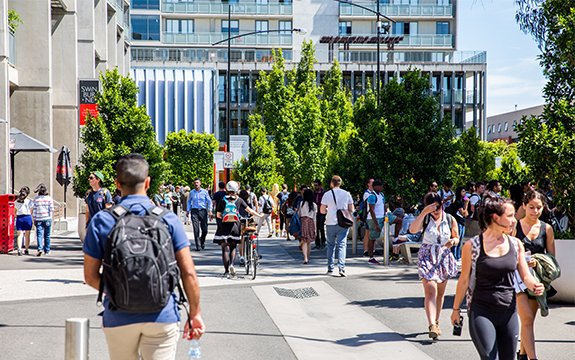Unis should develop ATAR alternatives

In Summary
- Opinion for The Australian by Professor Linda Kristjanson AO, Vice-Chancellor, Swinburne University of Technology
In the recent flurry of media articles concerning the utility or otherwise of the Australian Tertiary Admission Rank, it is easy to overlook the wellbeing of our students.
Regrettably, despite the valid criticisms raised in the Mitchell Institute’s report Crunching the Number: Exploring the Use and Usefulness of the Australian Tertiary Admission Rank, the ATAR is perhaps more important than ever to students as they vie for a finite number of undergraduate places thanks to a government cap announced at Christmas last year.
But I do not believe it has to be this way.
The ATAR is certainly not worthless as a metric, and it may play a valuable role in determining aptitude for certain disciplines in a transparent fashion. Yet even its most staunch defenders must concede that it is a blunt and imperfect instrument, a crude measure of a student’s engagement at a particular point.
From a student’s perspective though, it can feel like the most important lottery — four digits that seemingly can determine the rest of their lives.
I am sure you have all been around students or at least have had stories related to you of the wait for Year 12 results. For some, the receipt of their ATAR brings sheer elation; for others, crushing despair. Yet for all, the wait is a highly anxious and often gut-wrenching affair.
The ATAR no doubt can be improved, and it must be if Australia is to recognise and encourage the broad range of capabilities that will be essential for the jobs of tomorrow.
Yet, in the interim, there are other options for our school students that are deserving of a significant scale up. Swinburne University of Technology's Alternative Tertiary Education Program, for example, is in its second year of operation, and has elicited strong community interest and support.
The ATEP is run in partnership with a student’s school and is not available independently. Students choose between project and curriculum streams and undertake a selection of first-year Swinburne subjects based on their interests, participating alongside undergraduate students.
On completion of the program, and provided they have met entry requirements, students are guaranteed a place in a Swinburne program that aligns with their goals.
ATEP students bring diligence and enthusiasm to their studies, free from the undue stress that the Victorian Certificate of Education can cause for some. They have been given a genuine alternative way to demonstrate their readiness for post-secondary studies.
Interest in the ATEP has grown beyond the initial pilot, and I would urge other universities to consider similar partnerships.
Without clearly defined alternative pathways to university such as ATEP, the reality is there is a two-tiered system in our schools. In Victoria, VCE students receive an ATAR and a pathway to higher education, yet those who graduate with a Victorian Certificate of Applied Learning do not.
This lack of pathway diversity at the secondary level must be addressed, and universities have an important role to play. The tertiary admissions centres in each state are more than capable of implementing a range of non-ATAR criteria; all we need to do is develop them.
Certain universities may wish to retain the ATAR, but it must no longer be the only game in town.
We also must remove restrictive caps on the sub-bachelor and enabling courses that play a vital role in preparing students for higher education and are proven to increase retention and completion rates. We came close to this eminently sensible policy decision last year, yet we must not give up on it.
The ATAR and its appropriate use certainly is worthy of our collective attention. Yet a far more significant barrier to student ambition is the capped environment in which our universities operate.
From this year we are unable to provide any more commonwealth supported places to prospective students than we did last year. This policy already has seen thousands miss out. The unintended consequences of this decision will be felt for years to come, but the immediate impact is universities have had to turn away those who have studied hard for years, only to have the goalposts for entry shifted at the last minute. In fact, to continue the football analogy, this occurred after the siren, given these changes were announced in December last year, well after applications had been lodged.
Coupled with an effective cap on places, many have observed that the ATAR becomes a rationing tool rather than a criterion for entry, and this is absolutely correct.
There is no doubt that not everyone belongs at university, but the opportunity must be available to those who have met an appropriate standard. It is this cap on ambition and access that is most retrograde in the government’s recent policy announcements.
Swinburne has chosen to enrol students above and beyond the commonwealth caps this year, not because there is money in it (there isn’t) but because it is the right thing to do, and we applaud other universities that are doing the same. We remain optimistic that this handbrake applied to our knowledge economy will be lifted before it is too late.
To the students across Australia working hard to secure entry to a degree of their choice, I urge you to keep up your fine efforts, yet not at the cost of your family, friends or mental health. You are more than a number.
Written by Professor Linda Kristjanson AO, Vice-Chancellor, Swinburne University of Technology. This article was originally published on The Australian. Read the original article.

